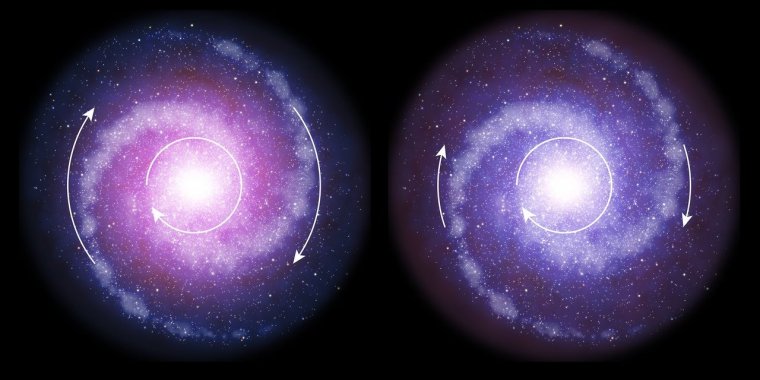| News / Space News |
Dark Matter Less Influential in Galaxies in Early Universe
New observations indicate that massive, star-forming galaxies during the peak epoch of galaxy formation, 10 billion years ago, were dominated by baryonic or “normal” matter. This is in stark contrast to present-day galaxies, where the effects of mysterious dark matter seem to be much greater. This surprising result was obtained using ESO’s Very Large Telescope and suggests that dark matter was less influential in the early Universe than it is today.

Comparison of rotating disc galaxies in the distant Universe and the present day. ![]()
We see normal matter as brightly shining stars, glowing gas and clouds of dust. But the more elusive dark matter does not emit, absorb or reflect light and can only be observed via its gravitational effects.
The presence of dark matter can explain why the outer parts of nearby spiral galaxies rotate more quickly than would be expected if only the normal matter that we can see directly were present.
An international team of astronomers found that unlike spiral galaxies in the modern Universe, the outer regions of these distant galaxies seem to be rotating more slowly than regions closer to the core — suggesting there is less dark matter present than expected.
There are probably two causes for this. Firstly, most of these early massive galaxies are strongly dominated by normal matter, with dark matter playing a much smaller role than in the Local Universe. Secondly, these early discs were much more turbulent than the spiral galaxies we see in our cosmic neighbourhood.
Both effects seem to become more marked as astronomers look further and further back in time, into the early Universe.
This suggests that 3 to 4 billion years after the Big Bang, the gas in galaxies had already efficiently condensed into flat, rotating discs, while the dark matter halos surrounding them were much larger and more spread out.
Apparently it took billions of years longer for dark matter to condense as well, so its dominating effect is only seen on the rotation velocities of galaxy discs today.
This explanation is consistent with observations showing that early galaxies were much more gas-rich and compact than today’s galaxies. (ESO)
YOU MAY ALSO LIKE



